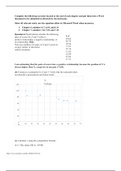Psy 520 topic 3 exercises Study guides, Class notes & Summaries
Looking for the best study guides, study notes and summaries about Psy 520 topic 3 exercises? On this page you'll find 18 study documents about Psy 520 topic 3 exercises.
All 18 results
Sort by
PSY 520 TOPIC 3 EXERCISES
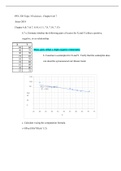
-
PSY 520 TOPIC 3 EXERCISE, CHAPTER 7 AND 8 ANSWERS
- Exam (elaborations) • 5 pages • 2021
-
- $15.49
- + learn more
PSY 520 Topic 3 Exercise Chapter 7 and 8 6.7 (a) Estimate whether the following pairs of scores for X and Y reflect a positive relationship, a negative relationship, or no relationship. Hint: Note any tendency for pairs of X and Y scores to occupy similar or dissimilar relative locations. (b) Construct a scatterplot for X and Y . Verify that the scatterplot does not describe a pronounced curvilinear trend. (c) Calculate r using the computation formula (6.1). 6.10 On the basis of an ...
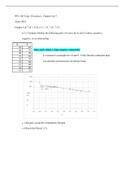
-
PSY 520 TOPIC 3 EXERCISE, CHAPTER 7 AND 8 ANSWERS
- Exam (elaborations) • 5 pages • 2021
-
- $14.49
- + learn more
PSY 520 Topic 3 Exercise Chapter 7 and 8 6.7 (a) Estimate whether the following pairs of scores for X and Y reflect a positive relationship, a negative relationship, or no relationship. Hint: Note any tendency for pairs of X and Y scores to occupy similar or dissimilar relative locations. (b) Construct a scatterplot for X and Y . Verify that the scatterplot does not describe a pronounced curvilinear trend. (c) Calculate r using the computation formula (6.1). 6.10 On the basis of an extensive su...

-
PSY-520 Topic 2 Exercises – Chapters 5 & 8 with Answers
- Exam (elaborations) • 9 pages • 2021
-
- $13.49
- + learn more
PSY-520 Topic 2 Exercises – Chapters 5 & 8 with Answers 5.11 Scores on the Wechsler Adult Intelligence Scale (WAIS) approximate a normal curve with a mean of 100 and a standard deviation on 15. What proportion of the IQ scores are a. above Kristen’s 125? z= 125-100/15= 1.67 using the z table on page 536 = 0.0475 b. below 82? z=82-100/15 = -1.2 C’=0.1151 c. Within 9 points of the mean? 100 +9=109 109-100/15=0.6 100-9=91 91-100/15=-0.6 B+B’ .2257+.2257 =0.4514...
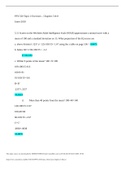
-
Grand Canyon University:PSY 520 Topic 2 Exercise,Chapter 5 and 8;Verified Answers(Graded A)
- Exam (elaborations) • 9 pages • 2022
- Available in package deal
-
- $10.49
- + learn more
PSY-520 Topic 2 Exercises – Chapters 5 & 8 Jones-2018 5.11 Scores on the Wechsler Adult Intelligence Scale (WAIS) approximate a normal curve with a mean of 100 and a standard deviation on 15. What proportion of the IQ scores are a. above Kristen’s 125? z= 125-100/15= 1.67 using the z table on page 536 = 0.0475 b. below 82? z=82-100/15 = -1.2 C’=0.1151 c. Within 9 points of the mean? 100 +9=109 109-100/15=0.6 100-9=91 91-100/15=-0.6 B+B’ .2257+.2257 =0.4514 d. More than 40 p...
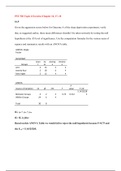
-
Grand Canyon University_PSY 520 Topic 6 Exercise:Chapter 16, 17, 18 COMPLETE SOLUTION
- Other • 14 pages • 2020
- Available in package deal
-
- $15.98
- 7x sold
- + learn more
PSY 520 Topic 6 Exercises 16.9 Given the aggression scores below for Outcome A of the sleep deprivation experiment, verify that, as suggested earlier, these mean differences shouldn’t be taken seriously by testing the null hypothesis at the .05 level of significance. Use the computation formulas for the various sums of squares and summarize results with an ANOVA table. 16.10 Another psychologist conducts a sleep deprivation experiment. For reasons beyond his control, unequal numbers of subj...
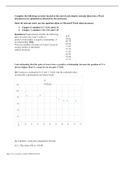
-
PSY 520 TOPIC 3 EXERCISES
- Exam (elaborations) • 5 pages • 2021
- Available in package deal
-
- $12.49
- + learn more
PSY 520 TOPIC 3 EXERCISES

-
PSY 520 Topic 6 ExerciseChapter 16, 17, 18, (Latest New Version-1): -Grand Canyon University
- Study guide • 14 pages • 2020
- Available in package deal
-
- $15.49
- + learn more
PSY 520 Topic 6 Exercise Chapter 16, 17, 18, (Latest New Version-1): -Grand Canyon University Grand Canyon University_PSY 520 Topic 6 Exercise:Chapter 16, 17, 18 COMPLETE SOLUTION PSY 520 Topic 6 Exercises 16.9 Given the aggression scores below for Outcome A of the sleep deprivation experiment, verify that, as suggested earlier, these mean differences shouldn’t be taken seriously by testing the null hypothesis at the .05 level of significance. Use the computation formulas for the various sum...

-
PSY 520 Topic 3 Exercise Chapter 7 and 8, (Latest New Version-2):-Grand Canyon University
- Study guide • 7 pages • 2020
- Available in package deal
-
- $15.49
- + learn more
PSY 520 Topic 3 Exercise Chapter 7 and 8, (Latest New Version-2):-Grand Canyon University Grand Canyon University:PSY 520 Topic 3 Exercise Chapter 7 and 8 COMPLETE SOLUTION;Graded A PSY 520 Topic 3 Exercise Chapter 7 and 8 6.7 (a) Estimate whether the following pairs of scores for X and Y reflect a positive relationship, a negative relationship, or no relationship. Hint: Note any tendency for pairs of X and Y scores to occupy similar or dissimilar relative locations. (b) Construct a scatterplo...
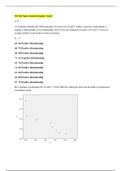
-
Grand Canyon University:PSY 520 Topic 3 Exercise Chapter 7 and 8 COMPLETE SOLUTION;Graded A
- Other • 6 pages • 2020
- Available in package deal
-
- $10.98
- 2x sold
- + learn more
PSY 520 Topic 3 Exercise Chapter 7 and 8 6.7 (a) Estimate whether the following pairs of scores for X and Y reflect a positive relationship, a negative relationship, or no relationship. Hint: Note any tendency for pairs of X and Y scores to occupy similar or dissimilar relative locations. (b) Construct a scatterplot for X and Y . Verify that the scatterplot does not describe a pronounced curvilinear trend. (c) Calculate r using the computation formula (6.1). 6.10 On the basis of an extensi...

